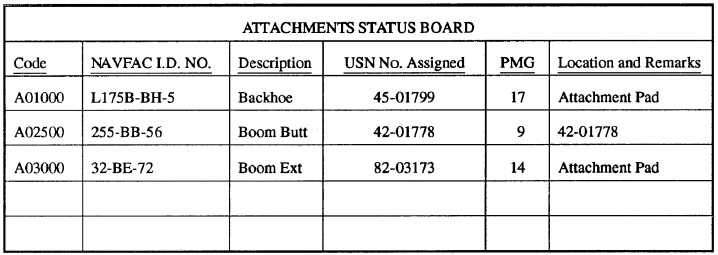The operators of Class B assigned
CESE signs the CB 60 form assuming full
custody of mounted collateral gear. CB 60
forms for Class C mounted collateral gear
on CESE are signed by the yard boss. The
mounted
collateral
gear
should
be
annotated on the daily (rip ticket, and
custody is assumed by the operator who
signs the trip ticket, or the collateral
equipage can be issued and returned to
collateral each time the unit of CESE is
dispatched.
ATTACHMENT CUSTODIAN
Attachments
are
accessories
to
construction
equipment
that
enable
the
basic equipment to perform its function
or
adds
versatility.
Attachments
are
stored on handstands to keep the items
out of sand, mud, and water. Hydraulic
lines
and
fittings
are
sealed
for
protection from dirt and moisture.
Attachment
accessories,
such
as
bucket teeth, sprockets, drum lagging, and
wedges, are placed in boxes or on pallets
and marked for the appropriate equipment.
Wire rope, sheaves, and bolt threads are
lubricated. Nuts and bolts are stored in
their respective holes on the attachments
when possible. Exposed machined surfaces
and open parts are preserved to prevent
oxidation
and
damage.
Storage
is
maintained to ensure attachments belonging
to one USN number are stored together.
The attachment custodian maintains a
card
file
and
log
that
provides
an
accurate inventory of receipts and issues
of attachments, when the attachments were
last lubricated, and any damage incurred
from
one
operation
to
another.
In
addition, the custodian is responsible for
the segregated storage of all attachments
and
their
associated
accessories.
The Attachments Status Board (fig.
1-13)
is
maintained
in
the
dispatcher’s
office by the attachment custodian. The
Attachments
Status
Board
reflects
the
attachment
code,
NAVFAC
identification
number, abbreviated description, the USN
number of the equipment to which the
attachment is assigned, the PM group (same
as
the
equipment
the
attachment
is
assigned), and location and remarks. The
collateral
equipage
custodian
usually
performs
the
duties
of
the
attachment
custodian.
FUEL OPERATIONS
The transportation pool manages all
fuel operations. The Equipment Operator in
charge of fuel operations must be mature,
independent,
and
reliable.
The
abilities
to communicate and to maintain logs are
also required. A poor fuel program results
in needless downtime of equipment and
delays
in
production.
The fuel truck driver reviews the
Equipment Status Board to determine the
location of all CESE. The driver learns
the fuel requirements and function of all
equipment used on construction projects by
communicating
with
the
project
crew
leaders, the assigned Equipment Operator,
and the transportation supervisor.
The
fuel
truck
driver
must
be
knowledgeable of all CESE. The driver must
avoid
fueling
with
the
wrong
fuel
or
filling hydraulic or cooling systems with
fuel.
Maintenance
and
transportation
super-visors
have
fuel
tanks
stenciled
with the words MOGAS or DIESEL to avoid
this problem.
Figure 1-13.—Attachments Status Board.
1-16


